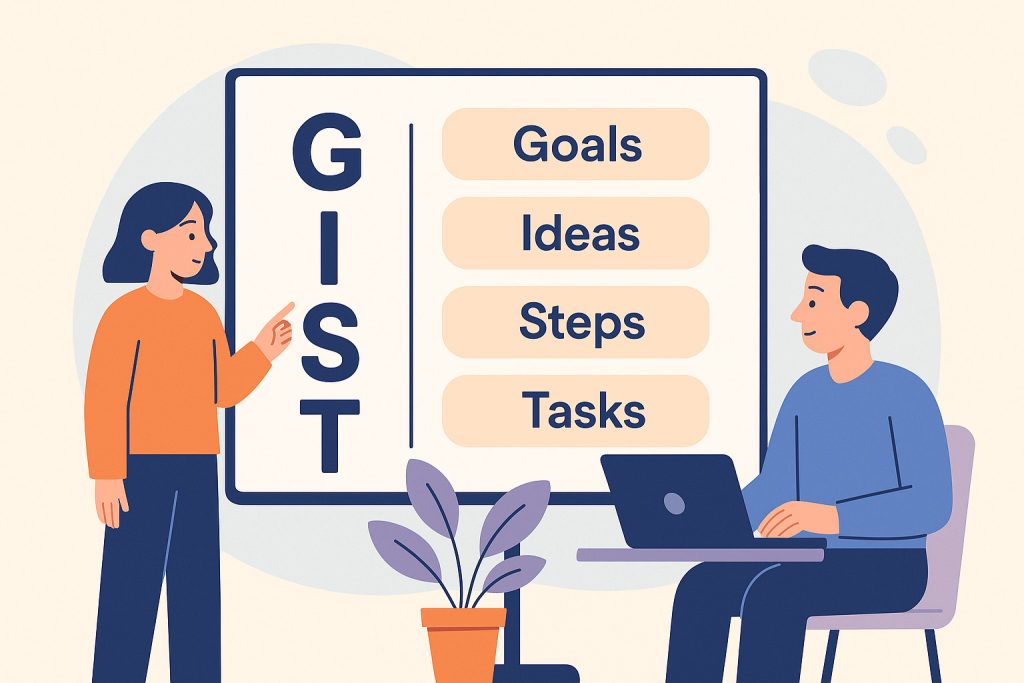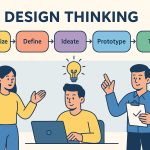What is GIST planning?
Every product team has experienced the frustration of launching something they were certain would succeed, only to watch it languish unused. The culprit is usually the same: a disconnect between what seemed logical in conference rooms and what actually solves problems for real users. This gap has persisted across industries and decades, costing organizations countless resources and opportunities.
GIST planning emerged as a response to this chronic misalignment. Developed by Itamar Gilad while working at Google, the framework represents a deliberate attempt to inject more learning and less guesswork into product development. The name itself—Goals, Ideas, Step-Projects, and Tasks—reveals its fundamental structure, but the real innovation lies in how it reorders priorities and reframes commitments.
Traditional planning often works backwards, starting with features someone thinks would be cool and then reverse-engineering justifications for why they matter. GIST flips this entirely, insisting that teams begin with concrete objectives and only then explore potential solutions. This isn’t just semantic tidying; it fundamentally changes which projects get greenlit and how resources get allocated. When everything must trace back to a measurable outcome, vanity projects and personal preferences have nowhere to hide.
The GIST planning process
The power of GIST lies not in any single component but in how the pieces connect, each building on what came before to create a coherent system for decision-making under uncertainty.
Goals
The foundation consists of objectives that actually mean something. Not mission statements or aspirational declarations, but specific targets that determine whether the business succeeds or fails. Revenue thresholds, customer acquisition numbers, retention percentages—the metrics that move the needle and command executive attention.
These objectives maintain relative stability over time, typically set on an annual cycle and sometimes extending multiple years into the future. This stability is deliberate, providing an anchor point while everything else remains in flux. However, stability doesn’t mean rigidity; periodic reassessment ensures these targets haven’t become irrelevant as markets shift and circumstances change. The balance is tricky—stable enough to provide direction, flexible enough to remain meaningful.
Ideas
With objectives established, attention shifts to the vast landscape of possible approaches. This phase deliberately encourages expansive thinking, welcoming any concept that might conceivably advance the established objectives. The key innovation here is permanence: suggestions don’t expire or lose relevance just because they weren’t immediately selected.
Instead, proposals live in what’s essentially a waiting room—a collection of possibilities ranked by various prioritization methods but never truly discarded. A concept suggested in spring might become the focus in autumn if circumstances make it more promising. Teams employ familiar scoring systems to create rough hierarchies, but these rankings serve primarily to determine testing order rather than final selection. The highest-ranked idea gets explored first, not necessarily implemented at all.
This perpetual consideration solves a persistent frustration in product work. Brilliant insights frequently surface at inconvenient moments, only to be lost because they don’t fit current plans. By maintaining this active repository, organizations preserve potentially valuable approaches that might otherwise slip through the cracks.
Step-Projects
Here the framework takes its most distinctive turn. Rather than committing fully to any particular approach, teams instead commit to limited experiments designed to validate assumptions. Each experiment runs for a maximum of ten weeks, with clear success criteria established upfront and multiple evaluation points throughout.
This constraint forces a different kind of thinking. Instead of imagining the complete, polished solution, teams must identify the smallest version that could test their core hypothesis. What’s the minimum viable experiment that would reveal whether this direction holds promise? This isn’t about building inferior products—it’s about learning efficiently before making large bets.
When experiments underperform, the response is straightforward: return to the collection of ideas and select a different approach to test. There’s no pressure to salvage failing initiatives or justify sunk costs, because the costs were deliberately kept small. This creates an organizational culture where failure becomes informative rather than embarrassing, where teams learn quickly rather than defending bad decisions.
Tasks
At the most granular level sit the individual work items that comprise each experiment. These will feel familiar to anyone who’s worked in modern development environments—small, discrete chunks that individuals or pairs can complete in short timeframes. The difference is context and purpose: these aren’t just backlog items to clear, but pieces of hypotheses to test, each contributing to a specific learning objective.
How is GIST planning used?
In practice, organizations adapt GIST to their specific contexts rather than following it religiously. While Gilad initially positioned it as a replacement for traditional planning documents, most teams find it works better as a complementary approach that informs rather than replaces existing processes.
The central philosophy emphasizes learning over prediction. Beyond the objectives themselves, nothing receives firm long-term commitments. Everything remains provisional, subject to revision based on what experiments reveal. This creates environments where discovering you were wrong is celebrated rather than punished, because catching mistakes early is precisely the point.
Pros and cons of GIST planning
Any framework involves tradeoffs, and understanding GIST’s limitations is as important as recognizing its strengths.
The benefits are substantial:
- Timing stops being destiny for good ideas. When teams continuously evaluate and reprioritize regardless of planning cycles, innovation can happen whenever insights emerge. A concept that surfaces between formal planning sessions can immediately compete for attention based on merit rather than waiting months for the next review cycle.
- Continuous testing prevents expensive failures. Rather than making large bets based on assumptions, teams probe ideas through bounded experiments. When hypotheses prove wrong, they discover this quickly enough to change course without significant waste. The psychological safety this creates is equally valuable—when all ideas are temporary and subject to validation, disagreement becomes easier and egos less fragile.
- Strategic alignment happens naturally. When every initiative must connect to explicit objectives, drift becomes immediately visible. Resources flow toward work that demonstrably advances organizational priorities rather than whatever seemed interesting at the time.
The challenges are equally real:
- The framework emerged partially from an outdated view of planning documents. It assumes most organizations use inflexible, waterfall-style approaches, but many modern teams already employ flexible methods that accommodate learning and adaptation without abandoning longer-term thinking entirely.
- Certain work genuinely requires extended commitment. Complex integrations, architectural migrations, and major platform changes can’t be meaningfully validated through ten-week experiments. When applied dogmatically, the framework can actually impede legitimate long-term initiatives that need sustained focus.
- Supporting functions struggle without visibility. Finance, operations, and talent teams need some sense of future direction to do their work effectively. When product teams can only specify objectives without indicating how they’ll pursue them, the rest of the organization operates in the dark.
Relevance to product management
Even teams that don’t embrace GIST entirely can extract valuable principles. The emphasis on testing over speculation addresses a genuine weakness in how many organizations operate. Product managers often think in terms of polished releases rather than learning opportunities, spending months perfecting features before any users interact with them. Breaking work into smaller experiments that reach users sooner reveals problems and opportunities that only emerge through actual usage.
The perpetual idea repository deserves broader adoption too. Traditional backlogs often become dumping grounds where concepts go to be forgotten, dismissed simply because they arrived at inconvenient moments. Systems that let ideas resurface based on changing circumstances and new evidence would improve decision quality across the industry.
Perhaps most valuable is how GIST forces explicit discussions about priorities and commitment levels. When teams must constantly validate assumptions and can’t retreat behind elaborate plans, disagreements surface early rather than festering. The framework provides a shared vocabulary for debating what deserves attention and why, even if teams ultimately communicate decisions through more traditional means.
The framework functions best as a philosophy rather than a rulebook. Its worth comes from the questions it raises and the assumptions it challenges, not from strict procedural compliance. Product managers who adapt the core principles—aggressive prioritization, systematic experimentation, explicit strategic alignment—to their specific contexts often achieve better outcomes than those treating GIST as doctrine requiring total adherence.
Getting the GIST of it
GIST planning represents meaningful progress in product thinking, though it’s not the universal solution some proponents suggest. The framework successfully pushes teams toward decisions grounded in evidence rather than enthusiasm, helping organizations avoid the trap of heavy investment before validating fundamental assumptions. By anchoring work to clear objectives and testing approaches systematically through bounded experiments, teams can learn what actually works rather than what sounded convincing in presentations.
What the framework really provides is legitimacy for staying flexible plus structure for doing so without chaos. Most product teams aren’t choosing between rigid plans and complete improvisation—they’re searching for the appropriate balance between commitment and adaptability for their situation. GIST tilts heavily toward adaptability, making it powerful for certain contexts while potentially constraining for others. Success comes from recognizing where your organization falls on that spectrum and adjusting accordingly, adopting what provides value while discarding what creates friction. Ultimately, the best approach is whichever actually helps you create better products, not whichever generates the most impressive slide decks.
Conclusion
What GIST planning ultimately teaches isn’t that elaborate roadmaps are worthless or that everything must fit ten-week cycles. Rather, it demonstrates that the space between strategy and execution should be filled with learning, not assumptions. When teams ground themselves in clear objectives, remain genuinely open to multiple approaches, and test their beliefs systematically, they naturally gravitate toward building things that address real needs rather than imagined ones. Whether you implement GIST completely or simply adopt its core emphasis on experimentation and strategic clarity, the fundamental insight remains valuable: superior product decisions emerge not from more detailed planning, but from greater willingness to learn and adjust based on actual results rather than confident predictions.


